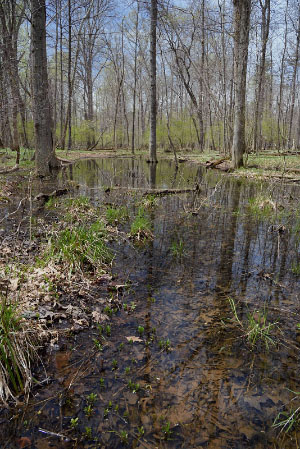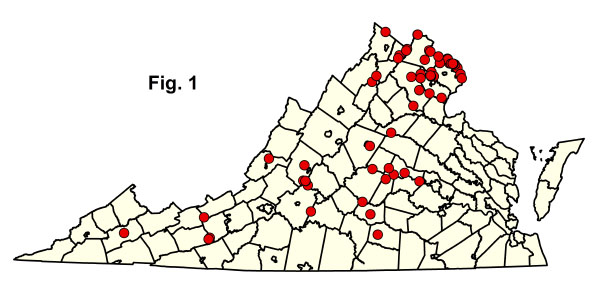
 保育與休閒部
保育與休閒部 保育。保護。享受。
 保育與休閒部
保育與休閒部  目錄
目錄皮埃蒙特/山地洪平原森林和沼澤
這些臨時到季節性洪水的森林包括北部和西部皮埃蒙特大部分河流平原棲息地以及主要山谷(除了被清除的山谷外)。
From the James River north, sandy river banks and first-bottom terraces that are frequently (but shortly) flooded support forests dominated by silver maple (Acer saccharinum) and boxelder (Acer negundo var. negundo), with herb layers containing many broad-leaved forbs such as wood-nettle (Laportea canadensis), clear-weed (Pilea pumila), and white snakeroot (Ageratina altissima var. altissima). Higher, better drained, sandy or silty river floodplains support mixed forests of sycamore (Platanus occidentalis), black walnut (Juglans nigra), hackberry (Celtis occidentalis), American elm (Ulmus americana), and boxelder, with understories of paw-paw (Asimina triloba) and spicebush (Lindera benzoin var. benzoin). Herb layers in the mixed floodplains are usually very lush with nutrient-demanding, early-season species such as Virginia bluebells (Mertensia virginica), Canada waterleaf (Hydrophyllum canadense), wild ginger (Asarum canadense), yellow trout-lily (Erythronium americanum ssp. americanum), white trout-lily (Erythronium albidum), Potomac River only), wild blue phlox (Phlox divaricata), miami-mist (Phacelia purshii), large solomon's-seal (Polygonatum biflorum var. commutatum), striped violet (Viola striata), and many others. Eastern cottonwood (Populus deltoides ssp. deltoides) is a frequent, early-successional pioneer of these habitats, while sycamore and river birch (Betula nigra) are pioneering invaders of stabilized depositional river bars.

Forested swamps are scattered in backswamps and sloughs of northern and western Piedmont and mountain-region rivers and large streams. Communities of this group are most common in the broad, clay-rich floodplain deposits of Piedmont Mesozoic basins, but occur locally throughout the northern and western parts of Virginia. Habitats generally have some hummock-and-hollow microtopography, with maximum flooding depths in hollows of 50 to 70 cm (20 to 28 in). Soils are usually white- or orange-mottled clay loams and loamy clays, with moderately low to moderately high base status. Characteristic trees of these swamps include pin oak (Quercus palustris), swamp white oak (Quercus bicolor), willow oak (Quercus phellos), green ash (Fraxinus pennsylvanica), red maple (Acer rubrum), American elm (Ulmus americana) and sweetgum (Liquidambar styraciflua). In the larger river backswamps, where flooding depths may exclude oaks, stands are usually dominated by combinations of silver maple (Acer saccharinum), red maple, and green ash. Small trees and shrubs include winterberry (Ilex verticillata), common elderberry (Sambucus canadensis), silky dogwood (Cornus amomum), and American hornbeam (Carpinus caroliniana). High-climbing woody vines, including poison ivy (Toxicodendron radicans var. radicans), grapes (Vitis spp.), and trumpet-creeper (Campsis radicans), are also typical. The herb layers of these communities are quite species-rich because of microtopographic diversity, but species tolerant of seasonal inundation are prevalent, including lizard's-tail (Saururus cernuus), false nettle (Boehmeria cylindrica), common wood reedgrass (Cinna arundinacea), winged monkeyflower (Mimulus alatus), and various sedges (e.g., Carex tribuloides, Carex typhina, Carex squarrosa, Carex grayi).
大多數皮埃蒙特/山水平原森林都受到了清潔、牧場、農業流水和侵入性雜草的嚴重影響。這些森林中許多已被破壞,而剩下的樹木(如果有)很少處於良好或原始狀態。大型、發展良好的沼澤森林在皮埃蒙特地區罕見,在山上很罕見。其中一些被水壩和水塘破壞或水文化改變。
參考文獻:Fleming ( 2002 a)、Fleming ( 2007 )、Fleming 和 Coulling ( 2001 )、Fleming 和 Patterson ( 2004 )、Lea ( 2000 )、Rawinski等人。(1996),范德霍斯特 (2000)。 © DCR-DNH,加里 ·P· 弗萊明。
© DCR-DNH,加里 ·P· 弗萊明。

 下載下面列出的每種社群類型的組成摘要統計資料表。
下載下面列出的每種社群類型的組成摘要統計資料表。

